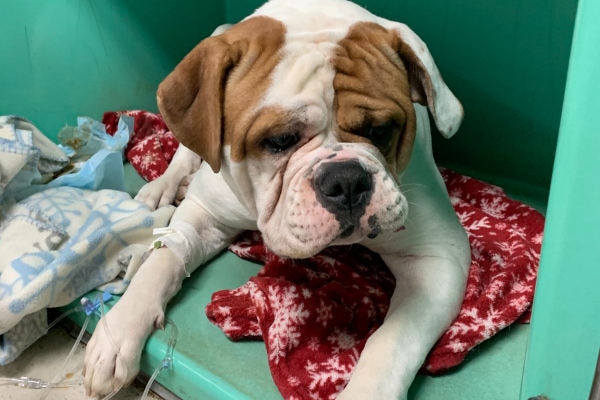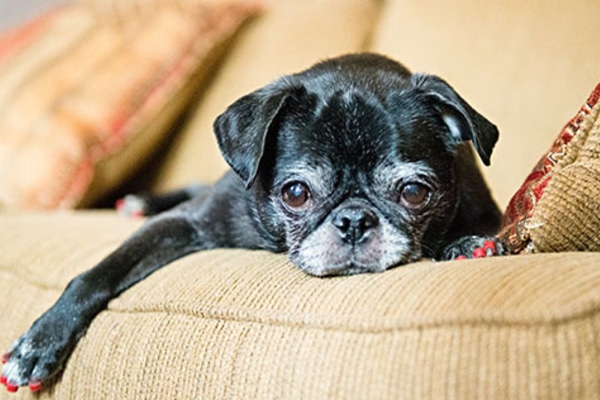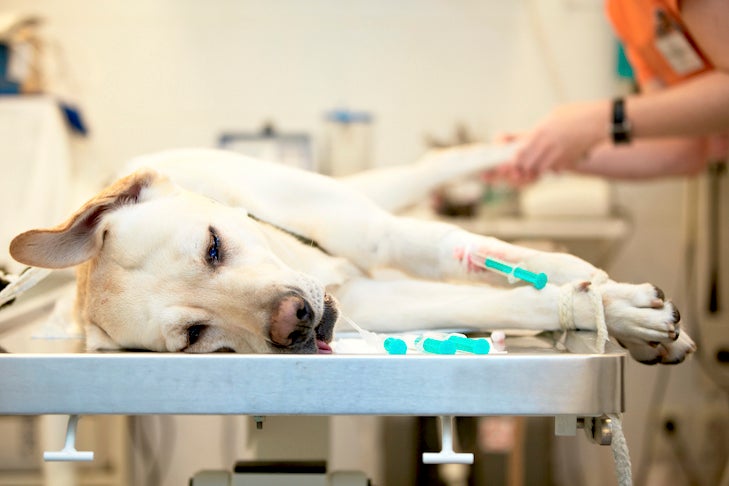The likelihood that Fido of Fifi will require surgery as they age due to illness, injury, dental problems, or other conditions increases, but so do the risks associated with administering anesthetics to them.
The good news is that getting anesthesia won’t put your dog in danger just because he’s getting older!
The overall situation can be made much safer – and less stressful for everyone – by considering general health, organ function, weighing the risks vs. benefits of any procedure, and proper testing/screening prior to anesthesia being administered.
Post-op monitoring: senior dog anesthesia recovery
You might be surprised to learn that the first three hours following a procedure are actually the most dangerous for anesthesia. Statistically, this is when most animals have adverse anesthetic events. Animals can perform well during surgery and then experience life-threatening complications afterward, as was the case with Teddy.

Every patient needs to be closely monitored after surgery, but older dogs who may have more difficulty breathing and getting around need it even more. Pre-operative testing, intraoperative monitoring, and a post-operative plan will all be laid out by your veterinarian. If your dog requires more involved procedures, he or she might advise an overnight stay or transfer to a facility that is open round-the-clock.
Senior dog anesthesia is a calculated risk
When I tell people I’m a veterinarian, they typically respond by saying they love animals but could never work in veterinary medicine because dog euthanasia is too heartbreaking. Although I obviously want all dogs to live forever, I don’t think that euthanasia is what hurts me the most. I have nightmares about losing a patient who is under anesthesia.
I lost a patient named Teddy while he was under anesthesia ten years ago. Teddy the Pug would have likely reached the age of 100 in “human years,” which was obviously a concern as we thought about using anesthesia for an elective procedure. In my professional opinion, Teddy needed a complicated dental procedure involving more than a dozen extractions because, by this point, he had more unhealthy teeth than healthy ones. I can say with certainty that I would have done the same for my dog.

What Are the Risk Factors for Dogs Undergoing Anesthesia?
Certain dogs have a higher anesthetic risk due to their breed, size, health, or age. These risks can run from minor problems, such as mild vomiting after recovery from anesthesia to life-threatening problems such as cardiac arrest or stroke. The American College of Veterinary Anesthesia and Analgesia advises that, “The anesthesiologist’s main task is to provide safe, optimal anesthesia, specifically tailored to your pet. Anesthesiologists are trained to administer anesthetics safely to patients who are sick, injured, pediatric, geriatric, or healthy.”
Size: The AAHA notes that due to their greater propensity for hypothermia, potential for difficulty intubating and monitoring, and propensity for overdosing, toy breeds are more susceptible to anesthetic complications. Giant breeds may also be more vulnerable because higher dosages are needed. A dog’s weight can also be a factor. Most vets prefer that your dog lose a few pounds before surgery if it is overweight and the procedure is not urgent.
Age: Due to changes in or immaturity of some of their body’s organs or systems, senior dogs and puppies may be at higher risk during anesthesia. However, Dr. “Age is not a disease, and the anesthetic risk is not significantly higher for a geriatric patient than a patient who is younger, as long as they are healthy with no co-existing disease,” says Berit Fischer, a member of the American College of Veterinary Anesthesia and Analgesia Board of Directors. ”.
Monitoring of the Recovering Patient by Trained Personnel is Critical The AAHA reports that almost half of anesthetic-related dog deaths occur during the first few hours of the postoperative period. Late-day and after-hours procedures have also demonstrated higher risk, most likely as a result of the limited time available for examination and stabilization of the dog and the possibility of more exhausted veterinary staff.

Making a plan before your dog receives anesthesia will help ensure that everything goes as smoothly as possible. Here are some precautions you and your veterinarian can take prior to, during, and following surgery.
Your dog’s physical examination by your veterinarian will likely include blood work, such as blood chemistry, blood count, and electrolyte testing, to ensure overall health is sufficient to prevent complications before even scheduling a procedure. Your pet’s medical background, including any allergies, will be requested. You can now inquire about the procedure, dangers, healing, and surgical alternatives.
You will be instructed not to feed your dog on the day of surgery for at least a few hours beforehand to lower the possibility of your dog aspirating food or fluid into the lungs. Your dog may be given a mild sedative when you get to the vet’s office, and after the area has been cleaned and shaved, an intravenous (IV) catheter will be inserted into a vein, typically in a leg.
Your dog is rendered unconscious by general anesthesia, so he is not conscious or in pain. Your pet will be observed and given care while being sedated in a manner similar to what you would.
According to the American Veterinary Medical Association, this may include intravenous fluids and/or medications to support your pet’s circulation and blood pressure; endotracheal tube inserted into your pet’s trachea (windpipe) to deliver the anesthetic gas and provide oxygen to your pet’s lungs; pulse oximetry to measure the oxygenation of your pet’s blood; blood pressure monitoring; temperature monitoring and warming blankets to prevent hypothermia (low body temperature); and electrocardiography to monitor your pet’s heart.
When the time comes for your dog to awaken, he will be put in a peaceful crate with cozy blankets and closely watched for any issues. Depending on the procedure and the animal’s health, some animals may be released from the hospital later that day if they recover well from the anesthesia and their pain is under control.
At this time, your vet should give you discharge instructions. It might take your dog a few days to get back to normal. Some dogs whine a bit when they first come home. Keep your dog warm but not overheated because it may take him some time to regain control of his body temperature.
FAQ
Is a 14 year old dog too old for surgery?
Age is not a disease, and even if your dog needs surgery and general anesthesia, they are never “too old” to receive the high-quality care they need.
Is general anesthesia safe for old dogs?
Although there is always a risk when undergoing anesthesia, older pets in good physical condition can do so without any issues. However, there are times when an older animal with a pre-existing medical condition needs surgery and specialized care.
How long does it take a senior dog to recover from anesthesia?
By the time of discharge, your dog should be nearly completely normal thanks to the modern anesthetics, many of which are reversible. Following anesthesia, many dogs experience twelve to twenty-four hours of sleepiness or fatigue.
Is anesthesia safe for 11 year old dogs?
As we often say, “age is not a disease. According to a study published by the National Center for Biotechnology Information (NCBI), there are typically no fatalities associated with anesthesia. 2%. Said otherwise, an average of 99. 8% of animals survive anesthesia, regardless of their age or state of health.